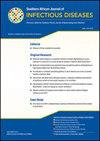Retrospective review of bacteriological profiles and antibiogram in a tertiary neonatal unit
IF 1.3
Q4 INFECTIOUS DISEASES
引用次数: 0
Abstract
Background: Neonatal sepsis remains a major cause of morbidity and mortality. Therefore, early detection and initiation of appropriate empirical antibiotic therapy are crucial.Objectives: The aim of this study was to describe the antibiogram of the neonatal intensive care unit at Grey’s Hospital, a tertiary hospital in KwaZulu-Natal.Method: This was a retrospective descriptive study, reviewing positive cultures from Grey’s Hospital tertiary neonatal intensive care unit (NICU) in KwaZulu-Natal, South Africa for a 3-year period (01 January 2017 to 31 December 2019). All positive cultures from all sites were included.Results: There were 1314 positive organisms cultured. Late-onset sepsis (89.3%) predominated over early-onset sepsis (10.7%). Blood was the source for 55.2% (725/1314) of positive cultures. Of the 1314 organisms cultured, 53.7% (706/1314) were Gram-positive, 45.7% (601/1314) were Gram-negative and 0.5% (7/1314) were Candida species. Klebsiella pneumoniae, 23.5% (313/1314) was the most frequent Gram-negative organism. It was noted to have high resistance to the unit’s first-line antibiotic regimens; 99% were resistant to ampicillin and 92% resistant to gentamicin.Conclusion: Blood cultures yielded most positive results with a predominance of Gram-positive organisms and late-onset sepsis. A significant proportion of the cultured organisms were resistant to the first-line antimicrobials utilised in the unit, ampicillin and gentamicin.Contribution: Ongoing surveillance on positive cultures is recommended to assess the effectiveness of the unit’s current empirical antimicrobial guideline.回顾性分析一家三级医院新生儿科的细菌学特征和抗生素图谱
背景:新生儿脓毒症仍然是发病率和死亡率的主要原因。因此,早期发现和开始适当的经验性抗生素治疗至关重要。目的:本研究的目的是描述夸祖鲁-纳塔尔省三级医院Grey医院新生儿重症监护病房的抗生素谱。方法:这是一项回顾性描述性研究,回顾了南非夸祖鲁-纳塔尔省格雷医院三级新生儿重症监护病房(NICU) 3年(2017年1月1日至2019年12月31日)的阳性培养。包括所有地点的阳性培养物。结果:共培养阳性菌1314株。迟发性败血症(89.3%)高于早发性败血症(10.7%)。血液是55.2%(725/1314)阳性培养的来源。其中革兰氏菌阳性53.7%(706/1314),革兰氏菌阴性45.7%(601/1314),念珠菌0.5%(7/1314)。最常见的革兰氏阴性菌为肺炎克雷伯菌,占23.5%(313/1314)。人们注意到它对该单位的一线抗生素方案具有高度耐药性;99%对氨苄西林耐药,92%对庆大霉素耐药。结论:血培养结果阳性,以革兰氏阳性菌和迟发性败血症为主。培养的微生物中有很大一部分对该单位使用的一线抗菌剂氨苄西林和庆大霉素具有耐药性。贡献:建议对阳性培养物进行持续监测,以评估该单位当前经验性抗菌指南的有效性。
本文章由计算机程序翻译,如有差异,请以英文原文为准。
求助全文
约1分钟内获得全文
求助全文
来源期刊

Southern African Journal of Infectious Diseases
INFECTIOUS DISEASES-
自引率
11.10%
发文量
50
审稿时长
52 weeks
 求助内容:
求助内容: 应助结果提醒方式:
应助结果提醒方式:


